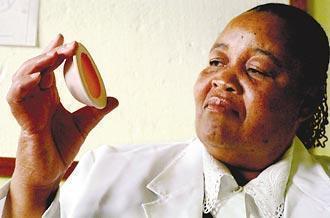"EVERY LITTLE BIT, if you make any difference at all, is going to help. I think you're morally obliged to look at anything and everything that has any potential."
Dr. Nancy Padian is the director of the Women's Global Health Imperative, based at the University of California, San Francisco. With $28 million in Gates money, her group will study whether diaphragms can slow transmission of HIV in Zimbabwe and South Africa. On a more fundamental level, her group is trying to give women a few tools — and a chance.
 |
| BETTY UDESEN / THE SEATTLE TIMES |
| Desperate to put protection into the hands of women, researchers are studying whether the diaphragm can block AIDS as it does other sexually transmitted diseases. Nurse Mavis Kamba helped direct a study to determine whether women in Zimbabwe would use the device. "Ooooh, yes, they liked it." |
|
 |
 |
"It's hard to put yourself in the place of Zimbabwean woman where there's a 25 or 30 percent chance of their husband being infected. Think about this in context: Just being married can be a really significant risk because you're having repeat contact with someone who has a high risk of being infected."
The diaphragm has been shown to protect against other sexually transmitted diseases such as chlamydia. It's unknown if it can block HIV, but it protects the fragile surface of the cervix, a "hot spot" for infection.
But would women use it? The Women's Global Health Imperative teamed with University of Zimbabwe to survey 405 women whose husbands refused to use male condoms. Of those, 18 percent used a diaphragm every time they had sex over six months; more than half used a diaphragm most of the time.
Everyone liked the device, many because their husbands didn't have to know they were using it. One had a husband who agreed to let her use the diaphragm, then reneged. Before they had sex, he checked the wardrobe to make sure the diaphragm was there. What he didn't know was that she had gotten a second from the clinic. Another woman bragged so enthusiastically about her diaphragm, a relative stole it to use herself.
"Iíd always wanted to invent something that would help people. Not anything earthshaking, but something."
— LISA TAM, PROGRAM FOR APPROPRIATE TECHNOLOGY IN HEALTH |

|
 |
 |
 |
 |
 |
Diaphragms aren't available in most of sub-Saharan Africa. Even in big cities, most clinics and pharmacies don't stock the devices, which come in more than a dozen sizes, must be fitted by clinicians and are relatively expensive to buy.
One woman came 200 miles from Mutare in search of a doctor who would fit her with a diaphragm. She was married to a businessman who had many lovers and refused to use condoms.
"It's scandalous we are not providing this method when we are well aware women cannot negotiate use of the condom," says Dr. Tsungai Chipato, an obstetrician/gynecologist in Harare and the lead investigator of the Women's Global Health Zimbabwe studies.
The doctor saw his first AIDS case 20 years ago when he was an intern in Bristol, England. The patient, a gay film producer from Paris, had pneumonia and tuberculosis and claimed more than 200 sex partners.
"At that time, we thought it was a European disease of homosexuals," he says. "We didnít think it would come to Africa."
Today, a third of his patients are HIV-positive. All of them are women.